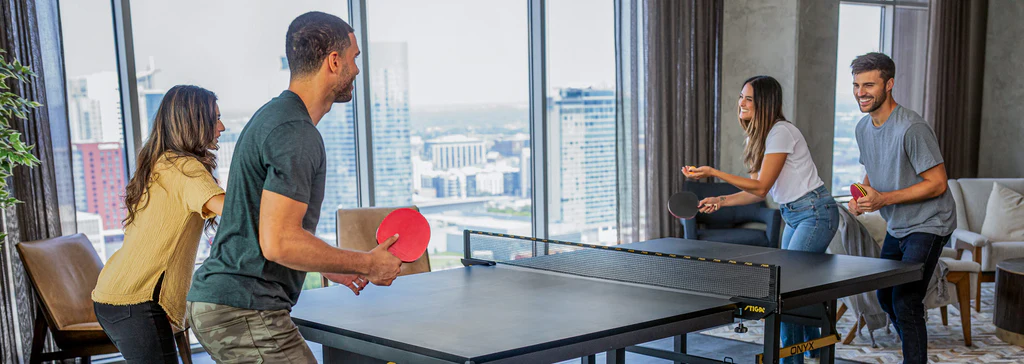
In the world of table tennis, serving isn’t just the first move—it’s the foundation of your gameplay. Whether you’re a casual player or aspiring champion, knowing the rules for table tennis serve gives you a strategic edge and ensures fair play.
This guide breaks down the most important regulations, covering everything from grip and toss to contact and follow-through. Let’s explore the proper serve rules in ping pong to help you step up your game.

Content
Rule 1: The Ball Must Rest on an Open Palm
A legal table tennis serve starts with the ball resting on your open, flat palm. This position prevents players from spinning the ball with their fingers or concealing their grip. It ensures visibility and fairness.
Avoid holding the ball with curled fingers or tossing it from a cupped hand. Referees at competitive matches are trained to spot these subtle infractions.
Rule 2: The Ball Must Be Tossed Vertically
You must toss the ball at least 16 cm (6 inches) straight up into the air—no sideways or angled tosses. This vertical toss is crucial because it gives your opponent a fair view of the ball’s motion.
A common error among beginners is tossing too low or flicking the ball directly onto the paddle. This can lead to an invalid serve.
Rule 3: The Ball Must Be Struck Behind the End Line
Your paddle must contact the ball behind the table’s end line and above the level of the playing surface. Any forward reach or body block is considered a fault.
These rules for table tennis serve ensure that each player begins the point under equal conditions.
Rule 4: Visibility Is Key
During the serve, the ball must remain visible to both the opponent and the umpire from the moment of toss until the point of contact. Hiding the ball behind your arm or body is against the rules.
This rule ensures transparency and prevents deceptive serves that could unfairly confuse the receiver.
Rule 5: Serve Must Land on the Opponent’s Side
In singles, a valid serve must land anywhere on the receiver’s side of the table. In doubles, however, it must bounce first on the server’s right-hand half, then the receiver’s right-hand half.
Understanding these distinctions is vital, especially when switching between singles and doubles play.
Rule 6: Let Serve Conditions
If the serve touches the net but still lands correctly, it’s called a “let” and must be replayed. A serve that hits the net and fails to reach the opponent’s side is a fault.
Let serves are common and non-penalizing, but too many in a row can disrupt rhythm and strategy.
Rule 7: Timing and Readiness
Before serving, make sure your opponent is ready. Quick or surprise serves are not only poor sportsmanship—they may be ruled invalid. Always confirm readiness, especially in recreational games.
Following this step adds professionalism to your match and ensures no point is unfairly earned.
Advanced Tip: Vary Your Serve Legally
Once you’ve mastered the basics, introduce variation—spin, speed, and placement. As long as the fundamentals are respected, variety in serving can keep your opponent guessing.
Even seasoned players must adhere to official rules for table tennis serve while adding flair and strategy.
Understanding Faults and Penalties
A fault is declared if any serve breaks the above rules. Two consecutive faults cost you a point. Consistently faulty serves can shift the game in your opponent’s favor.
That’s why practicing the mechanics of a legal table tennis serve is just as important as mastering your backhand or footwork.
Equipment Requirements for Legal Serving

- Ball: Must weigh 2.7 grams and be 40mm in diameter.
- Table: Regulation tables are 2.74 meters long and 76 cm high.
- Paddle: Must have one red and one black side, with uniform thickness and friction.
Knowing your equipment is compliant ensures your serve isn’t invalidated on a technicality.
The Role of Serve in Strategy
Serving isn’t just about starting a rally. A smart serve sets the tone for control, offense, or deception. Players at all levels leverage serving tactics to dictate pace and tempo.
Focus on both consistency and creativity. Once the ping pong serve rules are second nature, your serve becomes a weapon.
Serve Rules for Tournaments
In sanctioned matches, ITTF officials enforce serve rules strictly. Every legal table tennis serve is monitored for compliance. Replay cameras and service judges often assist in ruling contentious serves.
Aspiring tournament players must practice with regulation in mind. Casual habits might not hold up under scrutiny.
Serving Myths Debunked
- Myth: You can bounce the ball on your side before tossing it. (False)
- Myth: Hitting the net during serve is always a fault. (False—it’s a let if the serve is otherwise valid.)
- Myth: Trick serves are illegal. (False—if done within rules.)
Clearing up these misunderstandings can prevent unnecessary faults and arguments.
Practice Drills to Improve Legal Serves

- Vertical Toss Drill: Use a ruler or string to practice 16 cm toss.
- Target Practice: Place zones on the opponent’s side to improve placement.
- Blind Toss Practice: Focus on consistency in toss height and paddle timing.
With repetition, you’ll internalize the proper serve rules in ping pong and gain confidence on the table.
Conclusion: Serve with Confidence
Mastering the rules for table tennis serve not only improves your game but also keeps matches fair and competitive. From recreational rallies to championship matches, a proper serve is your opening move—and your opportunity to seize control.
By following these detailed guidelines, you can ensure every ping pong serve you make is legal, effective, and strategically sound. Now grab your paddle, perfect that toss, and serve your way to victory! For a detailed guide on official sizes, check out our article on Table Tennis Table Dimensions.
In table tennis, a legal serve requires the ball to be tossed vertically and struck behind the table’s end line. Players must ensure transparency in play. To reach enthusiasts, you can also advertise with us for targeted sports audiences.
FAQ’s About Rules for Table Tennis Serve
Q1: What is the most common serve fault in table tennis?
The most common fault is not tossing the ball vertically to 16 cm. Players often flick the ball directly from the hand, violating the official rules for table tennis serve
Q2: Can I hide my serve in casual play if both players agree?
While recreational matches allow some leniency, it’s best to practice legal serving habits. This ensures you’re always ready for competitive or tournament-level play.

Eldon Barrett’s knowledge of sports is boundless. His in-depth analysis and captivating storytelling will make you see the games you love in a whole new light.

